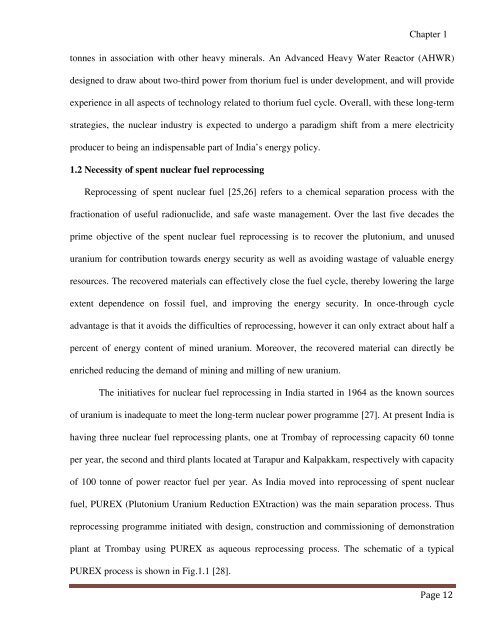CHEM02200704003 Nilamadhab Pandhy - Homi Bhabha National ...
CHEM02200704003 Nilamadhab Pandhy - Homi Bhabha National ...
CHEM02200704003 Nilamadhab Pandhy - Homi Bhabha National ...
You also want an ePaper? Increase the reach of your titles
YUMPU automatically turns print PDFs into web optimized ePapers that Google loves.
Chapter 1<br />
tonnes in association with other heavy minerals. An Advanced Heavy Water Reactor (AHWR)<br />
designed to draw about two-third power from thorium fuel is under development, and will provide<br />
experience in all aspects of technology related to thorium fuel cycle. Overall, with these long-term<br />
strategies, the nuclear industry is expected to undergo a paradigm shift from a mere electricity<br />
producer to being an indispensable part of India’s energy policy.<br />
1.2 Necessity of spent nuclear fuel reprocessing<br />
Reprocessing of spent nuclear fuel [25,26] refers to a chemical separation process with the<br />
fractionation of useful radionuclide, and safe waste management. Over the last five decades the<br />
prime objective of the spent nuclear fuel reprocessing is to recover the plutonium, and unused<br />
uranium for contribution towards energy security as well as avoiding wastage of valuable energy<br />
resources. The recovered materials can effectively close the fuel cycle, thereby lowering the large<br />
extent dependence on fossil fuel, and improving the energy security. In once-through cycle<br />
advantage is that it avoids the difficulties of reprocessing, however it can only extract about half a<br />
percent of energy content of mined uranium. Moreover, the recovered material can directly be<br />
enriched reducing the demand of mining and milling of new uranium.<br />
The initiatives for nuclear fuel reprocessing in India started in 1964 as the known sources<br />
of uranium is inadequate to meet the long-term nuclear power programme [27]. At present India is<br />
having three nuclear fuel reprocessing plants, one at Trombay of reprocessing capacity 60 tonne<br />
per year, the second and third plants located at Tarapur and Kalpakkam, respectively with capacity<br />
of 100 tonne of power reactor fuel per year. As India moved into reprocessing of spent nuclear<br />
fuel, PUREX (Plutonium Uranium Reduction EXtraction) was the main separation process. Thus<br />
reprocessing programme initiated with design, construction and commissioning of demonstration<br />
plant at Trombay using PUREX as aqueous reprocessing process. The schematic of a typical<br />
PUREX process is shown in Fig.1.1 [28].
















